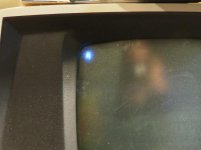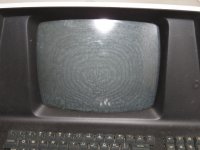Upcoming Events:
- VCF South West - June 14 - 16, Davidson-Gundy Alumni Center at University of Texas at Dallas
- VCF West - Aug 2 - 3, Computer History Museum, Mountain View, CA
- VCF Midwest - Sept 7 - 8 2024, Schaumburg, IL
- VCF SoCal - Mid February 2025, Location TBD, Southern CA
- VCF East - April 2025, Infoage Museum, Wall NJ
-
Please review our updated Terms and Rules here
You are using an out of date browser. It may not display this or other websites correctly.
You should upgrade or use an alternative browser.
You should upgrade or use an alternative browser.
Blurry screen on Soroc IQ 120 monitor
- Thread starter ilyaz
- Start date
NeXT
Veteran Member
You look to have a dreadfully massive cataract that has formed and the decaying pva glue is clouding the screen. It is fixable but you need to remove the crt to clean it up.
ilyaz
Experienced Member
You look to have a dreadfully massive cataract that has formed and the decaying pva glue is clouding the screen. It is fixable but you need to remove the crt to clean it up.
Thank you!
Eudimorphodon
Veteran Member
Thus I don't think this is relevant to any computer monitors.
Actually bonded-on glass over the front of the CRT seems to have remained "not uncommon" at least through the 1970's. The HP Computer museum calls it "screen mold" and it apparently affects quite a few late 70's-early-80's HP computer models. Because there's no standard name for it it's a difficult problem to search for but using "screen rot" turns up mention of it affecting systems at least as late as the DEC Rainbow. On some later systems the bonded-on glass might well be there as an anti-glare filter or leaded glass thrown on there to compile with European radiation emission standards, not necessarily safety glass.
ilyaz
Experienced Member
Here's a photo of the whole screen. Hopefully the camera flash did not distort it too much, You can see concentric circles which appear to be on the inside of the glass, since I don't feel any sort of layer of anything when I touch the glass with my finger.
Does this make... I guess the picture any clearer ?
Thx
Does this make... I guess the picture any clearer ?
Thx
Attachments
Chuck(G)
25k Member
My vote's for bad PVA also. You'll have to remove the CRT--and quite possibly the tension band before tackling the removal of the shield.
If you have a heat gun or hair dryer that can be set fairly low, you might try using it on a small section to see if the PVA will reflow. Note: you shouldn't have the heat set hot enough to melt the plastic faceplate.
If you have a heat gun or hair dryer that can be set fairly low, you might try using it on a small section to see if the PVA will reflow. Note: you shouldn't have the heat set hot enough to melt the plastic faceplate.
NeXT
Veteran Member
Wow. Yeah, that's a totally developed cataract. Typically it starts as spots around the edges of the tube face and over time creep inwards.
Just link to the video. https://www.youtube.com/watch?v=5l1EoMmmOcQ
If you have a heat gun or hair dryer that can be set fairly low, you might try using it on a small section to see if the PVA will reflow. Note: you shouldn't have the heat set hot enough to melt the plastic faceplate.
Just link to the video. https://www.youtube.com/watch?v=5l1EoMmmOcQ
ilyaz
Experienced Member
Thanks everyone!
I'll give it a try
I'll give it a try


